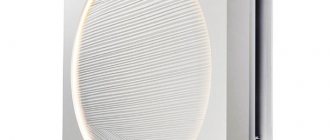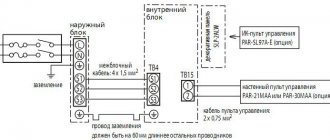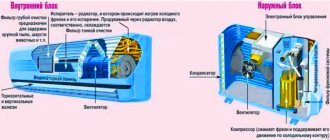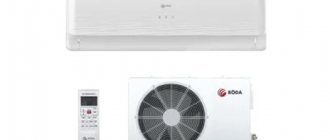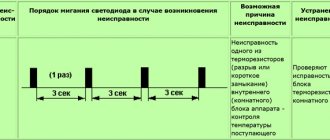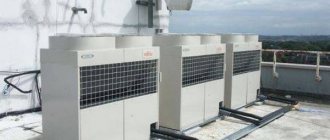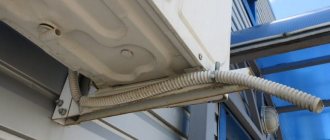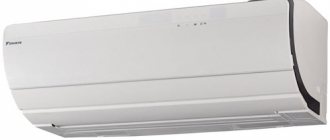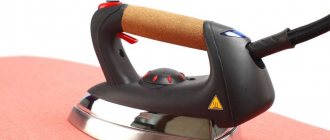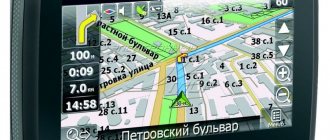To choose a split system for a home, for an apartment with optimal parameters, you need to compare the area and parameters of the room with the power of the device, analyze the required functionality and modes, temperature range, and the ability to adjust air flows. Additional options are appreciated: humidification, auto control. It is important to correctly determine the size of the device: regular or inverter; on the wall, floor; channel, window.
What is a split system
The split system is a type of climate control equipment, air conditioning systems (ACC), and air conditioners. In this case, the products are not monoblock, but with two blocks spaced apart from each other: external and internal. There are window modifications that have a monoblock body, but the blocks in such a box are still divided (one side is exposed outside, the other is inside the room). If on the facade of a building hangs a familiar box with a fan, and sometimes with a tube from which condensation drips, then this is a split.
Two separate units in the air conditioner make expanded functionality possible: the equipment works not only for cold, but also for heating. The system is considered more economical than monoblock air conditioners. Disadvantage of the device: one of the blocks must be mounted on the outside (from the street) of the walls, which often requires the services of construction climbers.
SELECTION OF SPLIT SYSTEMS
Most of the internal blocks have a dull office look, which does not fit with the ideas about the aesthetics of the home. Only a few manufacturers pay serious attention to the appearance of air conditioners. Among the successful design developments, we note several series of Artcool (LG). Thus, the Artcool Slim line is distinguished by an elegant, 177 mm thick body with a dark glass finish and LED backlighting. Artcool Gallery air conditioners have a square rather than rectangular body with a thickness of only 129 mm. You can insert a photograph or reproduction of a painting into the front frame. The devices of the newest Artcool Stilist series have a milky-white square body with an inscribed circle, decorated with dynamic lighting. LEDs allow you to simulate sunset, dawn and other dynamic lighting scenarios.
Timberk split systems: Laguna Nero series, completely varnished black body (a); Corona Lite series with Moon Light display (6)
To make the air conditioner last a long time
Before using the product, remove air and moisture from the refrigerant pipes and heat exchanger of the indoor unit. For this purpose, a special device is used - a vacuum pump.
The thing is that oil circulates in the hydraulic circuit of the air conditioner along with the refrigerant, with the help of which the moving parts of the compressor are lubricated. It is very hygroscopic, that is, it strongly absorbs moisture, upon contact with which it oxidizes, which leads to increased wear on the compressor and its rapid failure. However, unqualified installers usually do not pay enough attention to this procedure and do not remove air from the air conditioner, or most often they do not have a vacuum pump at hand. Please note that putting into operation a device that has not been properly prepared is unacceptable. While evacuation of the route is the key to durability and preservation of the air conditioner’s performance.
A little about refrigerant
The refrigerant in household split systems is located in the outdoor unit at the time of installation; most often it is charged taking into account the length of the route of 5 m. That is, if the length of the communications exceeds 5 m, for the correct operation of the air conditioner it is necessary to refill the refrigerant.
Over time, it may partially evaporate from the device during operation, then it has to be added. You can top up refrigerants R22 and R410A (but not more than 30% leakage, since the latter includes two components with approximately the same degree of volatility). It is not recommended to add R407C refrigerant to the system: it consists of three components with different volatility, so it must be completely replaced.
Inverter air conditioner ArtCool Stylist (LG) is one of the most interesting in terms of design
How to choose a split system for your home, 1.0 out of 5 based on 1 rating
Device, principle of operation
What do split systems consist of:
- outer part with compressor, impeller and condenser (radiator);
- internal (evaporative) part, inside the building with a fan, thermostatic valve, air ducts with horizontal and vertical louvres that regulate the flow of treated air. The radiator of this part is called the evaporator;
- thin pipeline with freon, condensate tray;
- filters (fine, coarse);
- nodes for advanced options: humidification, odor removal, etc.;
- control units, electronics, power supply.
The operating principle of split SCVs is similar to air heat pumps; it is based on the property of substances to absorb heat during evaporation and release it when entering a liquid state. In this case, cooling occurs due to the transformation of freon. The equipment consists of units that condense (compress) and dilute the refrigerant.
Stages of operation of a split system:
- The compressor creates low pressure, compresses the freon, while its temperature rises to +75... +85 °C, after which the refrigerant becomes gaseous and enters the condenser.
- Next, the substance is sent to the evaporator, where it cools down, since the unit is cooled by the air flow, and again turns into liquid. In the internal segment, a thermostatic valve, using capillaries, adjusts the degree of pressure and pressure, lowering/increasing the temperature to the values set by the users.
- The liquid refrigerant in the evaporator, in the process of cooling the room environment, absorbs heat from there, turning again into a watery state, and returns to the compressor. If the system operates for heating, then the described cycle occurs in reverse.
What is the difference between a split system and a monoblock air conditioner?
A split system, unlike single-block air conditioners, can operate for both heating and cooling. Such expanded functionality is achieved precisely because of the presence of two separate blocks, which also makes the system much more efficient.
The use of monoblock units is limited to relatively small areas. Splits are more efficient and can serve literally any size premises, from kitchens, small rooms to industrial and large office facilities.
Types of split systems
What determines their choice, pros and cons, which of them are most common and popular. As noted above, the device consists of two separate blocks - internal and external.
Both elements are connected to each other using copper tubes and electrical cables. The main differences concern the device mounted indoors.
Here are the following options for split systems:
- Wall-mounted.
- Floor-standing.
- Ceiling-mounted.
- Duct.
- Cassette.
- Floor-ceiling.
Before choosing a split system, it is worth understanding the features of its placement. Each type of device is designed for a specific room. For example, wall-mounted split systems are more suitable for apartments and private houses. This type of device is household.
As for other types of products, they fall into the commercial category.
Their peculiarity lies in their ability to serve rooms where there are a large number of people.
Despite their greater efficiency, there is no point in installing commercial air conditioners in ordinary apartments with a small area.
This is due to the fact that it will not be possible to fully use the capabilities of such models, but you will have to overpay for using the split system.
Some experts do not agree with this opinion. They assure that duct and cassette air conditioners, as well as floor and ceiling split systems can be used in a private home.
The main thing is that the selection and installation is carried out by a professional. The peculiarity of duct and cassette split systems is that they require a large ceiling space.
They do an excellent job of air-conditioning rooms with high ceilings or unusual geometric shapes.
In addition, complex systems are more economical compared to classical devices.
Duct air conditioners
Some experts claim that the best solution is ducted air conditioners.
Their advantages:
- Compactness. Such devices take up minimal space and can be installed in a hallway or utility room;
- You can do without installing an indoor unit. Instead, special grilles are installed in the room, which can be easily matched to any interior;
- With one unit you can cool and ventilate several rooms at once;
- Ensures uniform distribution of air in a room of any shape, including irregular ones.
But there is one difficulty. To install and configure such a split system in an apartment or house, you must invite a specialist who will wisely approach the placement of air ducts, the indoor unit, and also quickly resolve any problems that arise.
It is worth highlighting one more significant disadvantage.
A ducted air conditioner guarantees that the average temperature is achieved for all rooms, and individual control becomes unavailable. In addition, due to the presence of channels, odors can be transferred between rooms.
Cassette air conditioner
If the room has a high ceiling, the best solution is a cassette air conditioner.
Its advantages lie in its ability to evenly distribute and renew the air in the room. But here, as in the previous case, you cannot do without a ceiling space - from 20 cm or more.
For channel devices, this figure is from 25 cm. It must be remembered that channel and cassette systems are important not only to choose correctly, but also to install taking into account existing rules.
This is due to the fact that the air and freon pipelines are behind the beautiful finish.
If the system fails, cost savings on installation may require more expensive and time-consuming repairs and restoration. When choosing, it is important to take into account not only the type, but also the power of the split system and its performance.
On average, 10 square meters of space requires 1 kW of power. This requirement is relevant for standard ceiling height (2.5 m). It is also worth considering the glass area, the number of people in the room, the presence of equipment and other heat sources.
That’s why you should turn to professionals in your field for help in choosing and installing. A good option is split systems with an air ionizer. Their peculiarity lies in the additional purification of the air, as well as its saturation with ions, which have a positive effect on well-being.
Such devices are often installed in children's rooms of private houses or apartments. An interesting option are air conditioners made using Mega Ion+Patrol Sensor technology. E
This is a Japanese development, the essence of which is the generation of negative ions with the OH group.
The latter removes harmful bacteria from the air and deactivates existing viruses. In addition, the overall efficiency of such split systems is 40-50 percent higher.
Inverter or conventional split system
There are two main types of split systems based on the operating technologies used - conventional (ON/OFF, “stop-start”) and inverter, with a unit that creates alternating current and uses it. Questions - which is better, inverter or conventional, which split system to choose for an apartment according to the type of technology - are considered at the beginning of the process of selecting a device, since this point affects all characteristics, price, and quality of work.
Advantages of inverter split systems
Inverter models are more modern. Advantages and differences from conventional ones:
- these are the quietest best split systems;
- If you need full heating in winter, then an inverter unit is definitely needed. Conventional models cool normally when outside is about +16 °C and above, and heat when not below −5 °C. Inverter split air conditioners are capable of heating an apartment at an outside temperature of −15 and even −25;
- conventional systems operate in on/off cycles. upon reaching the set temperature, which is why they are also called ON/OFF. In fact, they operate only in 2 modes: maximum and minimum. Inverter air conditioners operate constantly, maintaining an optimal climate without sudden jumps, smoothly changing their power.
Myths and relativity of advantages of inverter split systems:
- the difference in electricity savings is noticeable only if the split SCV operates 24 hours, which, for example, is relevant for southern countries. If you turn off the device when leaving the place of employment in the morning, and turn it on for a short period after arrival, then both systems will use maximum modes, and this characteristic will not differ much. For use in the average statistical conditions of our country, the economy of the two systems does not determine the choice;
- If we consider what are the reliable best split systems, then due to the smooth operation, the service life of inverter models is longer. But this plus is also relative and noticeable if the device is used 24 hours or most of the day. In the mode described above, the operating period is almost the same.
Flaws
Choosing inverter air conditioners has its disadvantages:
- The devices are complex and costly to repair: if the external unit breaks down, the services of two craftsmen will be required - a refrigeration technician and an electronics engineer. Spare parts are more expensive and harder to find;
- inverter splits are sensitive to the quality of electricity supply. The disadvantage is mitigated by reliable automatic protective shutdown (RCD, RCBO) and grounding, which is always mandatory, regardless of the type of equipment. But theoretically, the risk of failure is greater.
Bottom line: inverter or conventional split air conditioner
Experts and craftsmen consider budget inverter systems to be evil - they often break down and are difficult to repair. Instead, it is better to buy a high-quality ON/OFF split model at the same price, for example, from expensive brands Daikin, Mitsubishi, General. Such an air conditioner will be more practical, easier and cheaper to maintain.
The inverter split is chosen by most users if full heating in winter and quiet operation are especially required - this is the only real advantage of such devices. It is recommended to buy products from the highest price echelon - they are less likely to fail and have a long warranty. The depth of adjustment for a high-quality device should not be lower than 25–80%, for example, the normal figure is 5–90%, which indicates a prompt response to temperature changes and efficiency.
How to choose a split system?
It is no secret that the air conditioner is selected for an apartment or house based on its size and power. This is where the knowledge of most users is limited. It's not always clear what you need to focus on first to achieve maximum efficiency while saving money.
Below we will consider the main aspects that you should pay attention to during the selection process.
Main settings
When purchasing a split system to create a climate in a house or apartment, you should focus on a number of criteria:
- Area and height of the room.
- Level of solar activity in the room.
- Number of people living.
- Heat sources (operating equipment).
- Other factors.
How about 1 kW of power. If the room is combined with another room, you need to add its area.
What is an inverter system and what are its features?
In the coming years, an increase in demand for inverter split systems, which are more economical, is predicted. On average, the use of inverter technology can reduce energy costs by 40-50%. In addition, the advantages include:
- Less noise level.
- Rapid achievement of the required temperature.
- Increased resource.
- Possibility of smooth change of temperature mode.
The disadvantage of an inverter split system is that it is sensitive to voltage changes and has a higher price. It is also worth considering that repairing an inverter air conditioner or replacing a faulty element will cost more, because most of the spare parts are not standardized.
POPULAR WITH READERS: All about plug sockets, classification, degrees of protection, selection criteria, installation features
The downside is that inverter split systems cannot be turned on when leaving the permissible temperature range. So, if a regular model starts up easily at -6 degrees Celsius, problems arise with the inverter device.
But this feature is an additional protection against improper operation.
Power
Special attention must be paid to the power of the device. Here, many people have a dilemma about how to achieve the required temperature in a large room without spending money on an expensive air conditioner. Such options must be immediately discarded. To cool a large area of an apartment or house, you need to buy a split system of appropriate power. In the process of calculating the indicator, it is worth taking into account:
- Room area;
- Ceiling height;
- The presence of heating devices (especially important when installed in the kitchen);
- Maximum number of residents;
- The number and size of windows, as well as their orientation in relation to the sun;
- Number of storeys. The higher the floor, the warmer it is inside the room.
To choose the right model by area, you need to know the performance (indicated in the abbreviation for the device) multiplied by three. As a result, you get the area of the apartment or house that can be cooled by the split system. For example, a designation with the number “12” indicates that the air conditioner is suitable for cooling 36 square meters.
The above type of calculation is suitable for a standard apartment and reflects only an approximate parameter. To get a more accurate indicator, you should turn to professionals.
But you shouldn’t buy devices with performance reserves. In this case, the compressor will constantly turn on and off, which will lead to a decrease in its service life. So, for an area of 21 to 27 square meters, an air conditioner with a “ten” or “nine” in the designation is more suitable.
Appearance
An important criterion that should be paid attention to is the external design of the split system. Most indoor units have a classic look, which is unlikely to appeal to connoisseurs of original interiors.
However, few manufacturers pay special attention to this aspect. Among the most interesting developments, it is worth highlighting Artcool from LG. For example, the main feature of Artkul Slim devices is an elegant body with a thickness of only 17.7 cm, a durable black glass finish, and LED backlighting.
Another option is Artcool “Gallery”. Unlike other devices, it has a square shape and the wall length is 12.9 cm. If desired, you can insert a picture or photograph into the front frame.
Another representative of this line, “Stylist,” has an original design. This split system has a milky white body with an inscribed circle and decorated with dynamic lighting.
Thanks to LEDs, it is possible to simulate sunset and other scenarios.
The more expensive the better?
There is a stereotype that the cost of a product directly determines its quality. This is a misconception. So, if we consider split systems for home or office, belonging to the middle and premium categories, the differences will be insignificant, and the difference in price will be very impressive.
Many manufacturers increase the cost of the device due to reduced noise levels, but in practice it is almost impossible to notice the difference.
The price of an air conditioner also depends on the installation of additional devices, including motion and activity sensors that save energy.
But what is the point of overpaying 10 thousand rubles if during the year you can only save 500-800 rubles on electricity. Also, when choosing, you should not focus on the country of origin. Products from China have long been equal in quality to goods from other countries.
Therefore, when choosing a split system, it is important to take into account two important criteria - the warranty period and the company that manufactures the product. Many are chasing compactness and lightness, which can be achieved by reducing the size of the heat exchanger.
As a result, the performance of the device suffers. More efficient filters may be installed in expensive models, but their effectiveness in protecting against viruses and bacteria is controversial and cannot be proven.
The service life of a split system, as a rule, depends on the main parameter - the quality of installation. So you shouldn’t buy an expensive model with free installation - you shouldn’t skimp on installation.
Types of compressors, and which one is better
The lifespan of the climate control device depends on the quality of the compressor. If a part suddenly fails, replacing it can cost half the price of a split system. That is why it is important to approach this nuance with special attention.
In modern models, compressors are hermetically sealed, so they cannot be repaired - the parts are installed as a whole.
There are several types of compressors:
- Rotary - devices with a rotating rotor. Their advantages are structural simplicity, uniform operation, low noise and compactness. In addition, such products are characterized by a lower price and increased reliability. The only drawback is that during their operation there are large friction losses. As a result, their use is possible only in low-power air conditioners. Although, such devices are also suitable for an apartment or house.
- Scroll compressors have a more complex design and are more expensive. Their advantages are a uniform and small load on the electric motor. This type of compressor has low noise, long service life, lightness and compactness.
- Piston compressors are obsolete types of compressors that are gradually going out of use. Their difference lies in their design simplicity and low cost. But the disadvantages are more serious - high noise, high vibrations and low reliability.
Taking into account the above, we can conclude that modern split systems for a house or apartment should be equipped with a scroll or rotary compressor.
Power and performance
If the power is insufficient, the unit will not be able to maintain the set temperature. There is also no point in overpaying for a split system with excessive performance if its full potential is not used; the equipment is quite voracious - from 2 kW and above.
Based on power, you can divide it into the following groups:
- weak - up to 2.5 kW. For small rooms up to 20 m²: children's rooms, bedrooms, kitchens;
- medium - up to 3.5 kW. For a regular living room 20–30 m²;
- high-performance - up to 4.5 kW, from 31 m²;
- the most powerful - from 4.5 kW and above. For large office areas, industrial and administrative facilities. Usually these are channel, cassette models.
Calculation
Calculation rules (ceiling heights up to 3 m):
- 1 kW per 10 m² plus a reserve of 25%, since more power will be required when in the summer the sun shines into the room most of the day;
- It is advisable to increase the reserve by 30%, or calculate based on 1.5 kW per 10 m², if the room is on the sunny side or has a lot of heating devices: in the kitchen, in an office with computers;
- number of people: 1 person in an office or apartment will require 100 W, but for restaurants and gyms this value should be increased to 300 W.
Systems are often called “sevens”, “nines”, these are parameters according to American standards - 9,000 BTU and so on. To convert to Watts, this value must be divided by 3.412. For rooms measuring about 20 m², “sevens” (7,000 BTU) are suitable, “nines” - for 27 m² - (9,000 BTU).
Usually average calculations are enough, but there are also formulas for more accurate calculations:
PRICE OF SPLIT SYSTEMS
The cost of air conditioners depends on the season. In winter, a system with a cooling power of 2-2.5 kW can be purchased for 8-10 thousand rubles. Systems of “premium” brands (Daikin, Fujitsu General, Mitsubishi Electric, Toshiba) cost from 30 thousand rubles. In the hot summer, the device will cost 20-50% more. And if the heat is intense, then purchasing inexpensive models will generally be difficult.
The price of a split system is affected not only by performance, but also by design features, for example, inverter control of engine power. This Panasonic development was once a hallmark of luxury technology, but today it is found in most models, with the exception of the cheapest lines. “Out of season” an inverter device can be purchased for 15-20 thousand rubles. But this technology justifies its use, since inverter air conditioners consume about 30% less electricity than conventional ones, and they are quieter.
Wall-mounted split system Fusion series (Electrolux). Cooling, heating, dehumidification, ventilation, six-stage air purification filter, display, control panel
Functional
All split systems have cooling and heating modes. The following features are also standard for quality devices:
- ventilation. Only the indoor unit works. The mode is useful not only in summer, but also in winter - it will allow you to evenly distribute warm air from the radiators throughout the apartment;
- drainage. Reducing humidity will lower the temperature by 2-3 degrees;
- night mode (“sleep”). The fan speed and, accordingly, noise are reduced. In this case, the temperature changes as smoothly as possible over the course of hours;
- auto control, autonomous operation, timer, programmability. Sensors record indicators (humidity, t°) and transmit them to the receiving unit, which reacts according to the parameters set by the user. The function allows you to set the on/off time, operating duration;
- turbo mode;
- two filters;
- 2 or more air flow directions;
- remote control (plus manual).
Feasibility of advanced and additional features
Advanced functions often serve more of an advertising role than a practical one, but at the same time they always significantly increase the price, so you need to decide whether the user needs them.
Let's evaluate which advanced options provide practical benefits and tangible comfort:
- Only filters from dirt and dust bring real benefit: if the heat exchanger becomes clogged, the level of heat removal will decrease and the compressor will burn out. All others - vitamin, catechin, Nano Silver, electrostatic, carbon, photocatalyst, etc. - are largely marketing ploys;
- ionization. Only large-sized ionizers provide a real effect, but they are extremely rarely installed on air conditioners. It is better to purchase such a product separately;
- Options for smooth temperature changes and draft protection are practical. Most people are familiar with the cooling effect of an air conditioner - it feels very sharp and can lead to a cold;
- odor removal, deodorization. Despite its apparent minor importance, this function will bring tangible comfort;
- hydration. Split systems dry out the air, so the option is required, but, unfortunately, such a function is rarely present in air conditioners;
- Practical benefits and comfort are also provided by: anti-icing, delayed start of the compressor to protect it, LED display on the case and on the remote control, control via the Internet and smartphone;
- motion sensors, “smart eyes” that redirect the flow towards a person or turn off the device in the absence of people are useful options.
What does the market offer?
Today, consumers have at their disposal many interesting models of split systems for homes, offices and apartments. Below we present the most interesting models.
Toshiba
Toshiba has pleased customers with many new products, including:
- Toshiba type RAS-07S3KHS-EE / RAS-07S3AHS-EE is a wall-mounted split system that is suitable for a home, apartment or office. The cooling area is 20 square meters. meters, and the maximum length of communications is 10 m. Features of the device include the presence of a ventilation mode, independent diagnosis of problems, a dehumidification mode and temperature support in the “automatic” mode. Maximum power consumption (for heating) - 1.94 kW. Manufacturer: Thailand.
- Toshiba, model RAS-22N3KVR-E / RAS-22N3AV-E is one of the manufacturer’s interesting new products. This is an inverter device for apartments and houses, designed for an area of 60 square meters. Power consumption for heating and cooling is up to 7.5 and 2.65 kW, respectively. The features of the split system include the presence of a 2-stage air purifier, which provides maximum effect thanks to silver ions. The maximum length of communications is 20 meters. Additional functionality - the presence of a ventilation mode, fault detection, maintaining the temperature in automatic mode. The noise level is in the range of 35-47 dB.
LG
LG products are no less interesting:
- LG A09AW1 is a split system with inverter control type, manufactured in Korea. The area of the refrigerated room is 22-27 square meters. meters. This is a wall mounted air conditioner with heating and cooling capacity of 3.5 and 2.7 kW respectively. Additional modes include self-diagnosis of breakdowns, automatic mode, the presence of additional filters (deodorizing and flame), the ability to regulate, a memory function, as well as a warm start.
- LG G07HHT is a split system with basic heating and cooling modes. Power consumption in heating and cooling mode is 2.7 and 2.5 W. Additional functions - dehumidification mode, on/off timer, remote control, fan speed control, option to remember settings and others. This is a simple split system for a house or apartment, which is characterized by its simplicity of design and reliability.
POPULAR WITH READERS: Help with electric shock
Midea
Chinese manufacturer Midea also offers many options. Below we consider two interesting models:
- MSMA1A-07HRN1/MOAB02-07HN1 is a wall-mounted split system that fits perfectly into the interior of a house, apartment or cottage. The peculiarity of the device is its wide functionality, relatively low price, and modern appearance. It provides options such as accelerated cooling, working with a temperature sensor, remembering settings and others. If the owners are absent for a long time, the unit can maintain the temperature for a long time, heating the room. The device is designed for an area of up to 21 square meters and operates in cooling or heating mode. Power consumption from 2.1 to 7.0 kW.
- Model MSMBB-12HRN1(W) / MOBA02-12HN1 is a high-quality split system designed for an area of 28-36 sq. m. meters. The product has a new design, has a comfortable sleep mode, a self-diagnosis function and an economic mode. If there is a refrigerant leak, the user is notified that there is a problem. The power consumption of the air conditioner is 3.5-3.6 kW in various modes. There is a remote control, as well as a timer to turn it off and on.
Mitsubishi Electric
Today, Mitsubishi Electric products are manufactured in Thailand. Below we look at several models:
- MSZ-DM25VA / MUZ-DM25VA is an inverter split system designed for an area of 22 to 27 square meters. meters. The power in cooling and heating modes is 2.5 and 3.15 kW, respectively. Among the useful options, it is worth highlighting the presence of a ventilation mode, self-diagnosis and a dehumidification mode. Control is carried out using the remote control. An important advantage is the presence of an option to remember settings, a system against ice formation, as well as changing the direction of air flow.
- MSZ-FH25VE / MUZ-FH25VE is an inverter-type split system. The power of the device is 2.5 and 3.2 kW in cooling and heating mode. There is a ventilation mode and automatic diagnostics. The area of the refrigerated room (apartment, house) is 22-27 square meters. meters. Among the additional functions, it is worth highlighting the presence of deodorizing and plasma filters, an ice protection system, an option to remember settings, and others.
Electrolux
Equipment under the Electrolux brand never ceases to pleasantly surprise. Let's highlight several models:
- EACS/I-07HSL/N3 is one of the highest quality and reliable split systems for an apartment or house, designed for an area of up to 21 square meters. meters. This is wall-mounted equipment with inverter control and low power consumption (2.1-2.6 kW). There are dehumidification and ventilation modes, there is self-diagnosis of breakdowns and adjustment of the fan speed. Additional options include a warm start, an option to remember settings, the ability to regulate air flow and others.
- EACS - 07HPR/N3 - split system from the Prof Air series. The average area of the room for which the device is designed is 20 square meters. meters. Power consumption is about 650 W. The main feature of such systems is the presence of a unique technology that ensures the cleaning of all air conditioner elements and air flow. At the same time, anyone can clean the filter.
Hyundai
It is impossible not to highlight several models from the manufacturer Hyundai:
- H-AC-07H1 is a split system designed for cooling or heating an area of up to 21 square meters. meters. The power of the device is 2.2-2.3 kW depending on the selected mode. Features include the presence of an ionizer, a convenient display, a remote control, and air purification filters. This is a reliable device that operates in several modes - heating, cooling, dehumidification and ventilation.
- H-AR7-07H is a split system from the Prime series. The air conditioner is designed to operate in a room with an area of up to 22 square meters. The model features an exclusive design, original indicator lights, many functions and operating modes, as well as an automatic shut-off timer. The power of the device is 2.2-2.3 kW depending on the mode. There is a display and control panel.
Neoclima
Many experts recommend products from the increasingly popular Neoclima brand. Let's highlight several models:
- NS-09AHQ / NU-09AHQ - split system for 25 sq. meters, with a capacity of 2.64 and 2.78 kW for cold and heat, respectively. Control is carried out via the remote control. The features of the model include the presence of a wave filter, a wide range of operating temperatures, relatively small dimensions and quiet operation. Heating work is carried out up to seven degrees below zero.
- NS-18AHQ / NU-18AHQ is a powerful split system that is suitable for a large apartment or house. The maximum area that the air conditioner can cover is 50 square meters. meters. Control is carried out from the remote control. Features: white color, sleep function, wide range of operating temperatures, compactness and low noise level.
Samsung
The popular Samsung brand deserves special attention, as it also offers customers a wide selection of air conditioners. Let's highlight some options:
- AR09KQFHBWKNER is a model that copes with heating or cooling a room up to 27 square meters. meters. The maximum length of the route during laying is 15 meters. The device is controlled via the remote control. The block is wall-mounted. A Full HD filter is installed inside, providing maximum air purification. The device can be turned on for heating down to five degrees below zero.
- AR12MSPXBWKNER is an air conditioner model that will be an excellent option for home and apartment. The device has enough power to heat/cool a room up to 35 square meters. meters. To clean the air, a special Virus Doctor filter is installed, which ensures the removal of harmful microbes. The consumption of the device is about 1 kW, and starting heating is possible even at 15 degrees below zero.
Daikin
Daikin offers customers split systems of several series. Let's look at some of them:
- ATXN-MB is a new series of air conditioners that can provide an optimal microclimate in the apartment and clean the air from foreign impurities. Features of split systems include the presence of a 2-row heat exchanger with gold plating, as well as improved main characteristics, including performance and energy efficiency. Devices in this series are distinguished by the presence of a powerful inverter, which ensures rapid achievement of the required temperature with minimal noise and low energy consumption.
- FTXB-C is an improved inverter-type split system with low noise levels and high-quality European assembly. The device is manufactured in the Czech Republic, which guarantees a long product life. The advantages of the series include the presence of an additional filter against animal hair, ticks, viruses, bacteria and various contaminants. Thanks to the presence of an inverter, the device quickly reaches the required temperature and wears out less. In this case, the cooled air is evenly distributed throughout the room.
- ATX are split systems that do an excellent job of cooling, dehumidifying, heating or ventilating air. The air conditioner operates thanks to a powerful compressor equipped with an inverter drive. During the development process, all current market trends, as well as customer wishes, were taken into account. Assembly is carried out in the Czech Republic, which is a guarantee of high quality. Thanks to the inverter, the desired temperature in the room is reached quickly and without jumps.
Installing a split system is a justified decision, because with its help you can ensure a comfortable temperature in any room, be it a house, apartment or office.
But to achieve the greatest efficiency, it is important to involve experienced installation specialists, because improper installation can eliminate all the advantages of the air conditioner and reduce its service life.
Expensive or cheap, energy consumption
Recognized brands have the following advantages:
- declared and actual characteristics always match;
- the design and installation details are thought out to the smallest detail;
- in a high-quality quiet split, the noise level of the room part does not exceed 20–25 dB, which is comparable to the quiet rustling of leaves outside the window. For inexpensive products, the indoor unit emits 28 dB, and the outdoor unit produces 40–50 dB. More powerful high-quality systems - 25s, 35s (25,000, 32,000 BTU) - have the same 28 and 40 dB, but for them this figure is normal due to high performance, but the noise of cheap devices in this power segment is accordingly, higher;
- high energy efficiency: A+++, A++, A+.
If you determine which split system from which company is better, the choice can be made in the low-price niche - there are quite decent products there, but the risk of getting defective is higher.
Market conditions make it possible to reduce the cost of production without reducing the quality of technology. Both little-known brands and popular brands use components from the same manufacturer in many models. A cheap air conditioner may work normally and rarely break down, but operating comfort, etc. will be less. The low price range is suitable if the user is not demanding on noise, but with advanced options if the yellowed plastic does not interfere and suits high power consumption.
Features of pricing policy
Cheap devices can do their job well, but buying products costs up to 15 thousand rubles. risky: this price is achieved by the lack of rejection and quality control. Reliable split systems should be chosen starting from the average price range of 20 thousand rubles.
One of the marketing ploys is the presence of copper tubes in the kit, but often the manufacturer is silent that their wall thickness is 0.6 mm, and for acceptable quality 0.8 mm is required. It is better to choose a good kit without these parts and buy them separately.
Dimensions
A reliable air conditioner should not be small, but moderately large, comparable to the area of the room and its power. Example: the internal part of a product with a parameter of 9,000 BTU (for 25 m²) should be from 790–800 mm in length and 270 mm in width.
The correct sizes are necessary for the following reasons:
- power and quality require larger parts and greater wall thickness, especially for heat exchangers;
- air outlet openings, louvres must be adequately large to effectively distribute flows in different directions and reduce noise.
A device that is too small will not be able to properly service and distribute coolness/heating; it is noisier. Usually, of two air conditioners of equal power, the larger unit is better, quieter and more efficient.
Assembly, materials
Based on the quality of assembly and plastic, if the user chooses a product via the Internet, then he should read user reviews.
If the split is selected directly in the store, then it becomes possible to inspect:
- ask the seller to open the lid - it should not be noticeably thin or flimsy;
- high-quality plastic with thick walls, bright white, without yellowness;
- ask to remove the mesh filter and inspect the heat exchanger - the petals should be free of jams and not too thin. Low-quality models have plates so thin that they crumple at the slightest touch.
Standard sizes
- Wall-mounted. Traditional size. One block is in the room (usually under the ceiling near the window), the other is a little lower on the outside of the building wall. This is a universal design, the product can be installed in apartments, houses, offices, and small shops. The only negative is that the power is usually up to 10 kW, which is enough for an area of up to 100 m².
- Duct. For installation under suspended ceilings. System with air channels around the perimeter of the premises. For large rooms, offices or for an entire apartment, country house. The power of the equipment is high - 5–25 kW.
- Cassette. The indoor unit is in the form of a square cassette with air outlets on the sides. Convenient to install behind a suspended ceiling. The side channels are bent at 30–35 degrees, with blinds, so the prepared air does not exit vertically downwards, but to the sides.
- Column, floor-ceiling. They differ in overall dimensions, are focused on high productivity, and can replace duct and cassette systems in the absence of suspended ceilings.
- Window monoblocks. Two blocks in one housing. A window or wall divides such a box into two parts - one is exposed outside (to the street), the second remains indoors. A practical solution, but there is a drawback: this type of installation reduces the thermal insulation of the room.
- Mobile, with remote blocks. The standard size allows you to move the equipment: all you need to do is move one of the blocks or the air duct outside. Pros: portable, no need for labor-intensive installation. Disadvantages: low power, noise, high price.
It is possible to combine different units, for example, one, paired or several external boxes serve internal air conditioners, including those of different sizes.
Types of split systems
The most commonly used are wall structures. Indoor modules are usually rectangular in shape. They are attached directly to the wall surface, parallel to the flooring. The power of cooling devices is greater than the power of mobile structures. Such equipment is used to maintain comfortable climatic conditions in a medium-sized apartment or office.
To cool larger rooms, column air conditioners are used. They have impressive dimensions and great power. They are installed on the floor. The device looks like a column. That's why it received a specific name. Typically, such structures are used to maintain the required temperature in restaurant premises, shopping and entertainment centers, bars, clubs and fitness halls, where large numbers of people gather. Air masses are cooled quickly. The air flow moves upward. The large size of the device does not prevent it from organically fitting into the design of the room. The developers took care of the stylish design of the device.
When installing floor-ceiling structures, two installation options are possible. Each position differs in the operating principle of the cooling system. When mounting the indoor module close to the floor surface, the air flow will be directed upward along the wall covering. If the installation is carried out on the ceiling surface, the movement of air masses will occur in a parallel plane.
To ensure that the air conditioner does not stand out and is invisible, cassette type cooling devices are used. It fits organically into the design of the suspended ceiling. Only the front part of the system is visible from the outside. The air conditioner has sufficient power and can be used to cool large rooms.
A similar installation method is used when installing structures with a channel device. They are also mounted under the surface of the suspended ceiling. Special air ducts are used to distribute cooled air. Through them, air masses enter various points in the room.
An example of a high-quality split system
When choosing the best split systems, you should take into account a unique minimum of functions and parameters, which, as a rule, are present in high-quality and first-in-reliability devices:
- modes other than cooling/heating: ventilation, quiet (“night”, “sleep”). If there is humidification, then this is an ideal option, but even in the premium segment it is rarely found in splits;
- auto control, programmability;
- manual and remote control (with remote control). Ideally, the system supports control from a smartphone;
- plastic, heat exchanger blades are thick;
- noise level up to 25 dB;
- protection system: monitoring the condition of filters, freon leakage, self-diagnosis with clearly deciphered codes, current sensor, auto defrost. There must be protection from low temperatures - it is extremely undesirable to start an unadapted air conditioner at sub-zero ambient temperatures; some models switch themselves off below a certain point, for example -5... -10 °C;
- the temperature range should not be too limited.
Choosing and determining from reviews which split system is better usually always helps to find the best option, so it is advisable to read user opinions on various sites.
Rating of split systems
The following rating of the best split systems should be regarded primarily as positions of brands and variants of product characteristics. Over time, models may become outdated, but the user will have a basis for guiding the quality of the product, which will allow him to make the right choice.
- Daikin FTXG20L. Premium segment, inverter, quiet operation (19 dB), motion sensors, multi-stage filtration, class A energy saving, anti-icing protection. There are not many advanced options, but this is compensated by extreme reliability.
- Mitsubishi Heavy Industries SRK-25ZM-S: inverter, auto mode selection, timer, auto restart, self-cleaning, self-diagnosis, 21 dB, air flow control (8 options), programmability. An impressive range of advanced options.
- Electrolux EACS-09HAR/N3. Two filters (air, antibacterial). There are adequately working self-diagnosis, self-cleaning, and programmability.
- Toshiba RAS-07EKV-EE/RAS-07EAV-EE. Inverter quiet split system. There is programmability, operation boost mode, economy mode (ECO), compressor start protection with a 3-minute delay.
- Hyundai HSH-S121NBE. Inverter system, low noise. Self-cleaning, double level of filtration, ability to set on/off time. High-quality plastic, assembly. The downside is that there is no vertical adjustment of the air flow from the remote control vertically (there is horizontal adjustment).
- Ballu BSW-07HN1/OL/15Y. One of the cheapest air conditioners, but it copes well with its tasks within its capabilities. Quite high-quality assembly, glossy thick plastic, the product is considered reliable and rarely breaks. Energy consumption class A, which is an excellent indicator for this level. Pros: low noise (24 dB), 4 speeds, modern environmental refrigerant R410A. Cons: sometimes modes change spontaneously. If you need a cheap working split system, then the device can be recommended with confidence.
- LG S09 SWC. Inverter air conditioner, noise level 19 dB. There is an ionization function, a deodorizing antibacterial filter, and auto-cleaning. The downside is that you often come across poor build quality.
- Samsung AR 09HQFNAWKNER. Cheap but high quality air conditioner. It is worth highlighting simple replacement and cleaning of filters. Cons: low cooling speed, noise.
- Kentatsu KSGMA26HFAN1/K. Two filters, high-quality assembly and materials, programmability, self-diagnosis, auto-protection, draft prevention function. Minus: noise level 31 dB.
- Haier HSU-07HMD 303/R2 is an excellent combination of price and quality. Disadvantage - the noise level of the indoor unit is 30 dB, energy efficiency D. There are 3 options for adjusting the air flow, 2 filters, odor elimination, programmability.
